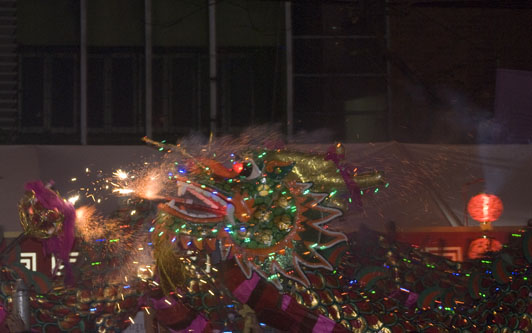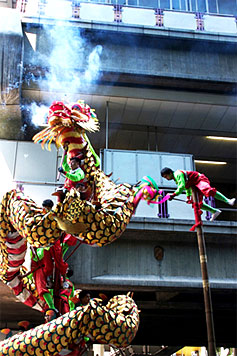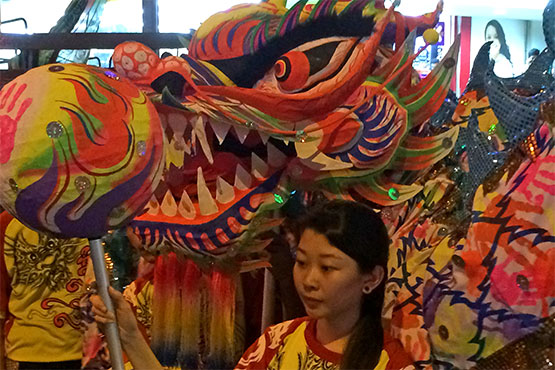Dragon Dance - Chinese Customs (original) (raw)

Chinese Dragon Dance performance, the Dragon on the hunt for the pearl of wisdom. Yaowarat (Chinatown), Bangkok. 2009 © photo: nationsonline.org
The Chinese dragons are associated with clouds and life giving rain, the original rain divinity provides for heavenly beneficence and fertility.
Types of Dragons
There are several types of dragons:
the Celestial Dragon (天龍, tiān lóng) guarding the heavenly dwellings of the gods;
the Dragon of Hidden Treasure (伏藏龍, fúcánglóng), guarding buried treasures, both natural and man-made;
the Earth Dragon (地龍, dìlóng), controlling the waterways, and
the Spirit Dragon (神龍, shén lóng), controlling rain and winds.
The Chinese dragon is also the embodiment of the concept of the yang force.
In Chinese mythology, dragons are believed to be able to create clouds with their breath, volcanoes are said to be created when dragons burst out of the ground to report to heaven.
The wise animal has special and great powers and dignity, symbolizing fertility, wisdom, auspiciousness and imperial authority. Furthermore, the dragon is the source of the elements - water, wind, earth and fire - and the custodian of the seasons, thus symbolizing life and prosperity.
The dragon is also one of the Twelve Symbols of Sovereignty (十二章紋) representing Chinese imperial authority.
Dragon Dance

Dragon Dance Performance, Silom Road, Bangkok
Photo: © Valeska Gehrmann
Dancing dragons can vary in size and length, starting from a few meters up to around 100m length. Dragons bring luck to people. The longer the creature is, the more luck it will bring. Especially if one is touched by a dragon, and even better if touched by a Golden Dragon, good fortune and prosperity will be coming up in the year to come.
The performance of the dragon dance is accompanied by the intense, mesmerizing rhythm of cymbals, gongs and the big drum.
The sound and the rhythm conduct the movement of the dragon.
The artistic of the dance team mimics the supposed movements of this spirit and hence brings the motionless body to life.
During the dance the performers hold poles and raise and lower the dragon, which is made out of fabric. The lead dancers lift, dip, thrust, and sweep the dragon's head, which may contain animated features controlled by the dancer and is sometimes rigged to belch fire and smoke from hidden pyrotechnic devices. One of the performers is carrying a sphere on a pole, the mystical 'Pearl of Wisdom' and his movments with the Dragon symbolizes the dragon's hunt for knowledge, wisdom, and the truth.
All the dancers within the dragon dance must cooperate to move the dragon's body in combination with the timing of the drum. The drum is not only used to beat a rhythm, but the loud noise of the instrument will scare away evil spirits and monsters like the giant Nian.
The Dragon Dance originated from the Han Dynasty (206 BC - 24 AD) and the tradition never faded. Originally performed to please the ancestors and to plead for enough rain for crops and hence preventing sickness and hunger, the Dragon Dance has gradually become a cultural activity. Since the Tang (618-907 AD) and Song Dynasty (960-1279 AD), Dragon Dances can be seen in every festival.
From its origins in combining stylized depictions of natural animals, the Chinese dragon evolved to become a mythical creature revered in Chinese culture. In Chinese art the dragon evolved from a limbless snake-like creature in the pre Qin dynasty (pre 221 BC) to the composite creature, a combination of many animals, including the horns of a stag, ears of a bull, eyes of a rabbit, claws of a tiger and the scales of a fish, all on a long serpent’s body. With these traits, it was believed that dragons were amphibious with the ability to move on land, fly through the air and swim in the sea, bestowing them roles as governors of cloud and rain in weather.
A fairy tale tells the legend: One day, the Dragon King felt some terrible pain around his waist. After consuming all medication he could find, the pain persisted. Without any other option, he turned into human form and sought for doctor's advice. After the inspection, the doctor claimed, "You are not a human." Realizing that he couldn't pretend anymore, the Dragon King turned into his original form. The doctor still helped, removing the pain from the dragon’s waist by a small operation and applied medication on the wound. The Dragon King felt relieve immediately. In appreciation to the doctor's help, the Dragon King said this to the doctor, "Dance in gears in the form of a dragon and you shall be granted with smooth weather and great harvests." The news quickly spread and people began to dance in gears built to the form of a dragon to plead for rain in drought seasons.

The Dragon with the Pearl of Knowledge; Dragondance performer in Kuala Lumpur, Malaysia.
Image: 2015 © nationsonline.org
Colors of Dragons and Patterns of the Dance
Rules for Dragon Dance include: Green for spring season and good harvest, Red for summer and excitement, White for autumn and Black for winter and Yellow symbolizing the sole empire. (All the colors symbolizing the Five Elements: Wood, Fire, Earth, Metal, Water).
Golden or silver colors symbolise prosperity.
The patterns of the dragon dance are choreographed according to the skills and experiences acquired by the performers. Some of the patterns of the dragon dance are "Cloud Cave", "Whirlpool", Tai-Chi pattern, "Threading The Money", "Looking For Pearl", and "Dragon Encircling The Pillar". The movement "Dragon Chasing The Pearl" shows that the dragon is continually in the pursuit of wisdom.
The dragon moves in a wave-like pattern achieved by the coordinated swinging of each section in succession. Whilst this swinging constitutes the basic movement of the dragon, executing more complex formations is only limited by a team’s creativity. The patterns and tricks that are performed generally involve running into spiraled formations to make the dragon body turn and twist on itself. This causes performers to jump over or through the dragon’s body sections, adding to the visual display. Other advanced manoeuvres include various corkscrew-like rotating tricks and more acrobatic moves where the performers stand on each others legs and shoulders to increase the height of the dragon’s movements.

Dragon Dance performance in Kuala Lumpur, Malaysia
Image: 2015 © nationsonline.org